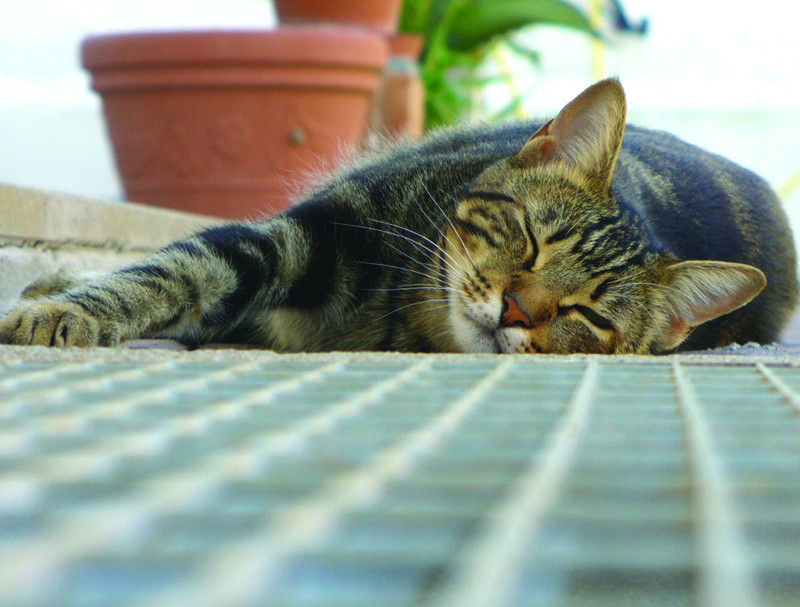Most cats enjoy being pampered, but that doesn’t mean they like to be brushed and bathed. Purr your way to peace with these tips for successful feline grooming.
Your guide to grooming tools
Glove
- Description: Cloth glove with soft plastic or rubber tips or bumps
- Hair types: All coat types, including hairless
- Use: Stroke cat with glove to remove loose hair and stimulate coat and skin
Slicker brush
- Description: Rectangular brush head with short metal pins
- Hair types: Short to medium coats
- Use: Not recommended for long coats except for undercoat removal (lift long outer coat and brush undercoat in small sections)
Pin brush
- Description: Oval brush head with long metal pins; choose ball-tipped pins for cats
- Hair types: Long hair
- Use: Smooths and detangles outer coat; reduces hair breakage; ball-tipped pins reduce damage to sensitive skin
Bristle brush
- Description: Rectangular or oval brush with short bristles
- Hair types: Short
- Use: Polishes coat, removes surface dirt and loose hair
Comb
- Description: Many tooth varieties – long, short, fine, wide, rotating, shedding
- Hair types: All hair types; choose tooth style to match hair length and thickness
- Use: Removes tangles, undercoat, foreign material
Flea comb
- Description: Short to medium length teeth set very close together
- Hair types: All hair types
- Use: The fine teeth of this comb catch and remove fleas on short to medium coats; difficult to use on long coats
Curry
- Description: Brush with soft plastic or rubber tips
- Hair types: Hairless to medium
- Use: Soft tips massage and stimulate hair and skin, and remove loose hair
“A cat pours his body on the floor like water. It is restful just to see him.” Written by American author and scholar William Lyon Phelps, these words are an apt description of just how well felines have mastered the art of relaxation. It’s a mastery we can take a few cues from, especially when we’re feeling stressed and need time out to recharge our batteries. Here are five ways your kitty can help you feel less frazzled.
What you’ll need to do
Brushing and combing
Cats need to be brushed daily, weekly or monthly depending on coat length and type. Begin with combing to remove mats, foreign material, and loose undercoat.
Follow this with a thorough brushing with a pin, bristle, or slicker brush to smooth the coat, stimulate the skin, and remove surface dirt. Many cats find brushing enjoyable and relaxing and will purr and stretch as you work on them.
Clipping
Cats should not be clipped on a regular basis unless there is a medical reason for it. Spot clipping may be necessary to remove stubborn mats.
Nail trimming
Indoor cats may need periodic nail trims to prevent damage to carpet and furniture. Find a quiet location, sit the cat on your lap, gently press the pad of the foot to extend the claw, and cut the white nail tip with a pair of scissor-style trimmers. Do not cut the pink line that is visible inside the nail; this is the quick and contains the nail’s nerves and blood supply. Never trim the nails of an outdoor cat as these are his primary defensive weapons. He needs his nails to protect him from other animals and to enable him to escape from danger by climbing a tree or wall.
Bathing
Some cats submit readily to bathing. These little gems sit quietly in the sink while being shampooed. Others consider bathing a form of torture and
will make their displeasure known. For these felines you have several choices: take the cat to a professional groomer, use a grooming sack, or use the bucket method (see below).
Whichever method you choose, remember these five important rules:
- Use only lukewarm water, not hot.
- Never submerge a cat’s head in the water.
- Protect her ears, eyes, and nose from soap and water.
- Rinse, rinse, rinse until all evidence of soap is gone.
- Stay calm if your cat gets upset, and talk to her in a gentle, reassuring voice.
Drying
Proper drying depends on the length and thickness of your cat’s coat. All cats should be toweled dried as thoroughly as possible following a bath. Short and medium-haired cats may then be allowed to air dry in a warm, draft-free environment. Long-haired cats may need to be dried with a human hair dryer. Use the lowest setting, hold the dryer at least eight inches away from the animal, and comb the fur as you dry to prevent tangles.
Once your cat gets used to being groomed, it can become a wonderful way to bond with her while you attend to her hygienic needs. Be patient and gentle and you’ll be rewarded with good behavior and a clean and healthy cat.
Soaps and shampoos
It’s very important to use only shampoos, conditioners, ear cleaners or grooming wipes specifically formulated for cats. Do not use products meant for dogs or humans, and never use household cleaners such as dish or laundry detergent.
When shopping for shampoos, look for mild, natural alternatives, such as gentle soaps and natural shampoos and conditioners. Only use medicated products on the advice of a veterinarian. Follow all label instructions carefully.
Getting kitty to co-operate
Unlike dogs, who often relish one-on-one grooming sessions, cats are not as fond of being groomed. They do not like restraint, water, or hissing spray bottles. Their skin is also incredibly sensitive, and improper combing or brushing can be painful or damaging.
The best ways to make grooming sessions less stressful are to:
- Begin training early, while your cat is still a kitten.
- Groom often to avoid mats and undercoat buildup.
- Keep grooming sessions short and sweet.
- Choose a safe, quiet setting without distractions.
- Always reward good behavior.
- Choose procedures, products and tools specifically suited to your cat’s coat type and health needs.
Bucket bathing
Most cats can be bathed in the sink, but for those who are very resistant, bucket bathing may be a better method.
Place several five-gallon buckets in your bathtub. Fill one bucket with lukewarm soapy water, the others with lukewarm clean water. Gently but securely scruff your cat with one hand and support her rear with the other. Then carefully lower her into the soapy water, being careful not to get any in her ears, eyes, nose or mouth. Never dunk the cat completely. Depending on her level of cooperation, gently rub the cat or just lift and dunk her several times. When you are satisfied that the shampoo has done its job, you are ready for the rinse cycle. Repeatedly dip the cat in the clear water buckets till all evidence of soap is gone.







No Comment